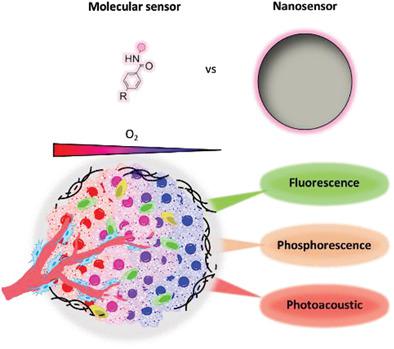当前位置:
X-MOL 学术
›
Adv. Healthcare Mater.
›
论文详情
Our official English website, www.x-mol.net, welcomes your
feedback! (Note: you will need to create a separate account there.)
Nano versus Molecular: Optical Imaging Approaches to Detect and Monitor Tumor Hypoxia
Advanced Healthcare Materials ( IF 10.0 ) Pub Date : 2020-11-25 , DOI: 10.1002/adhm.202001549 Miffy Hok Yan Cheng 1 , Yulin Mo 1, 2 , Gang Zheng 1, 2, 3
Advanced Healthcare Materials ( IF 10.0 ) Pub Date : 2020-11-25 , DOI: 10.1002/adhm.202001549 Miffy Hok Yan Cheng 1 , Yulin Mo 1, 2 , Gang Zheng 1, 2, 3
Affiliation

|
Hypoxia is a ubiquitous feature of solid tumors, which plays a key role in tumor angiogenesis and resistance development. Conventional hypoxia detection methods lack continuous functional detection and are generally less suitable for dynamic hypoxia measurement. Optical sensors hereby provide a unique opportunity to noninvasively image hypoxia with high spatiotemporal resolution and enable real‐time detection. Therefore, these approaches can provide a valuable tool for personalized treatment planning against this hallmark of aggressive cancers. Many small optical molecular probes can enable analyte triggered response and their photophysical properties can also be fine‐tuned through structural modification. On the other hand, optical nanoprobes can acquire unique intrinsic optical properties through nanoconfinement as well as enable simultaneous multimodal imaging and drug delivery. Furthermore, nanoprobes provide biological advantages such as improving bioavailability and systemic delivery of the sensor to enhance bioavailability. This review provides a comprehensive overview of the physical, chemical, and biological analytes for cancer hypoxia detection and focuses on discussing the latest nano‐ and molecular developments in various optical imaging approaches (fluorescence, phosphorescence, and photoacoustic) in vivo. Finally, this review concludes with a perspective toward the potentials of these optical imaging approaches in hypoxia detection and the challenges with molecular and nanotechnology design strategies.
中文翻译:

纳米与分子:检测和监测肿瘤缺氧的光学成像方法
缺氧是实体瘤的普遍特征,它在肿瘤血管生成和耐药性发展中起关键作用。常规的缺氧检测方法缺乏连续的功能检测,并且通常不太适合动态缺氧测量。因此,光学传感器为以高时空分辨率进行无创成像低氧提供了独特的机会,并能够进行实时检测。因此,这些方法可以为针对这种侵略性癌症的个性化治疗计划提供有价值的工具。许多小型光学分子探针可以实现分析物触发的响应,并且其光物理性质还可以通过结构修饰进行微调。另一方面,光学纳米探针可以通过纳米限制获得独特的固有光学特性,并可以同时进行多峰成像和药物递送。此外,纳米探针提供了生物学优势,例如改善了生物利用度和传感器的全身递送以增强生物利用度。这篇综述全面概述了用于癌症缺氧检测的物理,化学和生物分析物,并重点讨论了体内各种光学成像方法(荧光,磷光和光声)的最新纳米和分子发展。最后,本综述以对这些光学成像方法在缺氧检测中的潜力以及分子和纳米技术设计策略所面临的挑战的观点得出结论。纳米探针提供了生物学优势,例如提高了生物利用度和传感器的全身递送以增强生物利用度。这篇综述全面概述了用于癌症缺氧检测的物理,化学和生物分析物,并重点讨论了体内各种光学成像方法(荧光,磷光和光声)的最新纳米和分子发展。最后,本综述以对这些光学成像方法在缺氧检测中的潜力以及分子和纳米技术设计策略所面临的挑战的观点得出结论。纳米探针提供了生物学优势,例如提高了生物利用度和传感器的全身递送以增强生物利用度。这篇综述全面概述了用于癌症缺氧检测的物理,化学和生物分析物,并重点讨论了体内各种光学成像方法(荧光,磷光和光声)的最新纳米和分子发展。最后,本综述以对这些光学成像方法在缺氧检测中的潜力以及分子和纳米技术设计策略所面临的挑战的观点得出结论。以及用于癌症缺氧检测的生物分析物,并重点讨论体内各种光学成像方法(荧光,磷光和光声)中最新的纳米和分子发展。最后,本综述以对这些光学成像方法在缺氧检测中的潜力以及分子和纳米技术设计策略所面临的挑战的观点得出结论。以及用于癌症缺氧检测的生物分析物,并重点讨论体内各种光学成像方法(荧光,磷光和光声)中最新的纳米和分子发展。最后,本综述以对这些光学成像方法在缺氧检测中的潜力以及分子和纳米技术设计策略所面临的挑战的观点得出结论。
更新日期:2021-01-20
中文翻译:

纳米与分子:检测和监测肿瘤缺氧的光学成像方法
缺氧是实体瘤的普遍特征,它在肿瘤血管生成和耐药性发展中起关键作用。常规的缺氧检测方法缺乏连续的功能检测,并且通常不太适合动态缺氧测量。因此,光学传感器为以高时空分辨率进行无创成像低氧提供了独特的机会,并能够进行实时检测。因此,这些方法可以为针对这种侵略性癌症的个性化治疗计划提供有价值的工具。许多小型光学分子探针可以实现分析物触发的响应,并且其光物理性质还可以通过结构修饰进行微调。另一方面,光学纳米探针可以通过纳米限制获得独特的固有光学特性,并可以同时进行多峰成像和药物递送。此外,纳米探针提供了生物学优势,例如改善了生物利用度和传感器的全身递送以增强生物利用度。这篇综述全面概述了用于癌症缺氧检测的物理,化学和生物分析物,并重点讨论了体内各种光学成像方法(荧光,磷光和光声)的最新纳米和分子发展。最后,本综述以对这些光学成像方法在缺氧检测中的潜力以及分子和纳米技术设计策略所面临的挑战的观点得出结论。纳米探针提供了生物学优势,例如提高了生物利用度和传感器的全身递送以增强生物利用度。这篇综述全面概述了用于癌症缺氧检测的物理,化学和生物分析物,并重点讨论了体内各种光学成像方法(荧光,磷光和光声)的最新纳米和分子发展。最后,本综述以对这些光学成像方法在缺氧检测中的潜力以及分子和纳米技术设计策略所面临的挑战的观点得出结论。纳米探针提供了生物学优势,例如提高了生物利用度和传感器的全身递送以增强生物利用度。这篇综述全面概述了用于癌症缺氧检测的物理,化学和生物分析物,并重点讨论了体内各种光学成像方法(荧光,磷光和光声)的最新纳米和分子发展。最后,本综述以对这些光学成像方法在缺氧检测中的潜力以及分子和纳米技术设计策略所面临的挑战的观点得出结论。以及用于癌症缺氧检测的生物分析物,并重点讨论体内各种光学成像方法(荧光,磷光和光声)中最新的纳米和分子发展。最后,本综述以对这些光学成像方法在缺氧检测中的潜力以及分子和纳米技术设计策略所面临的挑战的观点得出结论。以及用于癌症缺氧检测的生物分析物,并重点讨论体内各种光学成像方法(荧光,磷光和光声)中最新的纳米和分子发展。最后,本综述以对这些光学成像方法在缺氧检测中的潜力以及分子和纳米技术设计策略所面临的挑战的观点得出结论。











































 京公网安备 11010802027423号
京公网安备 11010802027423号